Sixth team
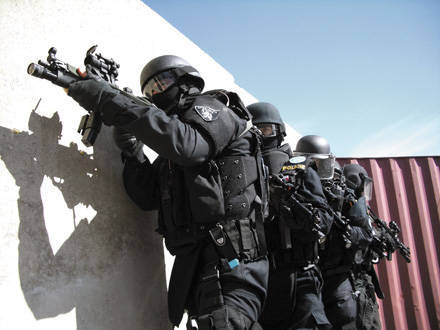
Tasks, structure, selection criteria
The main tasks of ST 6 were to conduct special operations to free hostages and detain especially dangerous armed criminals, persons suspected of committing war crimes, crimes against humanity, representatives of various terrorist and extremist organizations; conducting special raids and arrests of persons suspected of drug trafficking and trafficking weapons; implementation of fire escort VIP support activities.
The subunit structure was extremely compact: a commander, two assault squadrons, and equipment officers.
In ST 6, besides the commanding staff and staff of the assault units, there were 1 – 2 medics, 1 – 2 qualified breeders (specialists in room penetration using explosives and burglary), 1 – 2 technical officers.
The commanders of ST 6 and combat groups have never been appointed by the senior management of the mission. All appointments were made by voting within the unit itself.
For admission to ST 6 the candidate had to meet several important criteria. First: to be an acting officer of the special police of his country, whose task is to release the hostages, and serve in it for at least two and a half years. The division was international, this is its uniqueness. The language of communication was chosen for understandable reasons, English (fluency in spoken and written English was provided as a general requirement for admission to the UN mission).
Second: to have a personal short-barreled weapon chambered for 9 x19 mm, independently provide yourself with 1000 ammunition per month for training practice. (By the way, only two officers of the special divisions of the Ministry of Internal Affairs of Ukraine, the only representatives of the countries of the former USSR who got into ST 6, faced their problem with the cartridge 9 x18 mm, faced the problem at this stage of selection).
Third: two times in a row to pass a practical test of fire training (pass and confirm). The candidate was given the opportunity to shoot the test twice with a break only for equipment stores. Excess time by at least 1 a second at one of the 5 stages - the test is not passed! If at least one of the bullets did not hit the target - the test is not passed!
Fourth: pass an oral interview. The interview was conducted by a commission of a commander, two commanders of combat groups, and one or two operators. The interview included a survey of the candidate about his service in his native unit, his specialization, work experience, participation in real operations, additional skills. Often slipped and provocative questions. Also the candidate was tested for knowledge of basic tactics.
He was offered various tactical tasks and demanded that the actions of the group be described in accordance with the proposed pattern of development of events. If the candidate was represented by a unit whose employees never served in ST 6, then the interview continued until the commission received a complete picture of it.
It is worth noting that, in addition to the above tests, an unofficial test of candidates was carried out, and, if necessary, inquiries were made about little-known subdivisions and the spectrum of their tasks.
Having passed tests well, the newcomer had to come up with a pseudonym for himself, which became his name for the entire service in the team (the minimum contract period was one year). Real names and surnames are not mentioned anywhere and never. The newcomer also received a call sign, which was used for radio talks and for drafting official documents throughout the entire service. The call sign could be changed if the operator was elected to the position of the commander of ST 6 or the commander of one of the two combat groups.
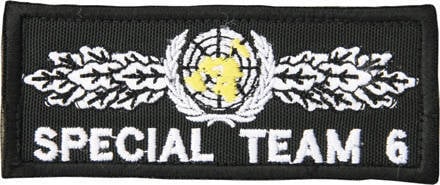
By the way, there was an informal part of admission to the unit. After passing all the standards, the newcomer was supposed to “register” in the team. He ordered a table in the restaurant for all members of the unit. After a hearty dinner, all employees moved to one of the bars, where tequila, salt and lemon were used. Here, the burden of financial investments was removed from the beginner (the team paid for everything). The newcomer had to drink with each ST 6 employee a stack of tequila with a “little note” in part of the traditional use of salt and a slice of lemon, namely: a handful of salt was inhaled by the nostrils, and the lemon was squeezed into the open eye. The opponent of the novice repeated the same procedure, after which the special forces were fraternizing, and the cherished phrase was pronounced to the general applause: “Welcome to the team!”
It is easy to imagine what the newbie’s eye and nose looked like the next day. But tradition is a tradition, and it was not only not violated, but was not a secret or an object of prohibition by the leadership of the special operations department of the UNMIK police headquarters in Kosovo. On the eve of the “registration” of newcomers, more often several at the same time, the commander of ST 6 informed the superior management in advance and received special permission. The department this evening knew: ST 6 in the next 12 hours "out of range".
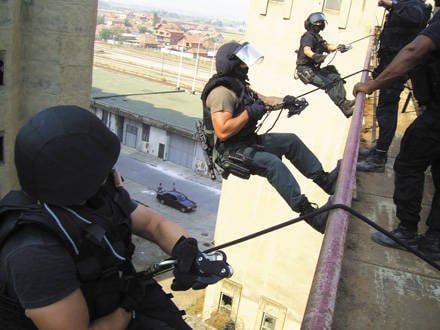
Armament, equipment, transport
The ST 6 operators were armed with MP5 N submachine guns, the shortened HK G36 KE assault rifle, and the Benelli M2 Tactical pistol grip smoothbore pistols. Sniper weapons, as well as explosives, were not used according to the rules of the UN mission. Pistols and the main part of equipment, as well as uniforms and armor, were brought by operators from their units.
The team had various hacking tools at its disposal: portable dresser sets, hydraulics, rams of various sizes and weights, as well as armored seats, US 95, AM 95, ZENTURIO 05 armored jackets, climbing equipment.
If necessary, the operator could use the required amount of light-noise devices for distracting action.
Each employee was provided with communication means: portable and trunking stations of Motorola, two or three satellite phones.
The ST 6 fleet was composed of Toyota 4 Runner SUVs, Toyota Land Cruiser 105 armored vehicles, and a multi-functional armored vehicle for the army and the RG-31 police, which was more often used in high-risk special operations.
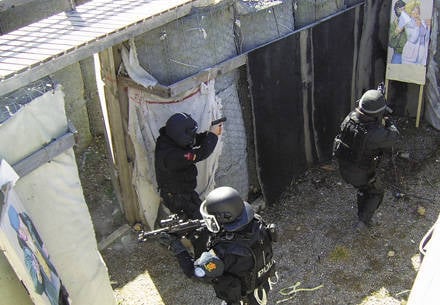
Training and combat work
The training of ST 6 operators included such disciplines as physical training, special fire training, terrain orientation, the use of special technical equipment and equipment, medicine, industrial mountaineering (working out descents on the outer side of buildings, as well as from helicopters of various models using mountaineering equipment and assault rope Fast rope).
Special tactical training was conducted as part of combat groups, as part of the entire unit, as well as with SPU (Special Police Unit) units from various countries. Objects for training were chosen throughout Kosovo, depending on the tactical design of the leader of each particular occupation, and technical equipment was provided to the sixth team by various services and units of UNMIK and KFOR immediately and without unnecessary delays.
To maximize the proximity of training to the conditions of real fire contact, special ammunition was used. This made it possible to fire at live “targets” from military weapons with special nozzles on the MP-5 N or from exact copies of military weapons, while retaining all the features of firing from a military pistol: recoil, reloading, etc.
There was a specific training schedule, where each operator of the team at the time of training in one of the disciplines became an instructor. Such a rule was advantageous for the whole department, as it made it possible to diversify the professional skills of employees. Also, on the basis of universal experience and knowledge, a uniform ST 6 tactic was developed, which, in turn, was caused by certain differences in the tactical training of units whose employees were represented in TEAM SIX.
The ST 6 special unit was in 24 alert status, 24 hours a day, seven days a week, and was used as a rapid response unit throughout Kosovo.
In the overwhelming majority of cases, applications for special operations were filed by investigative units of the UN police and the KFOR command in advance, which contributed to the careful planning of further actions. The required intelligence information was collected both independently by ST 6 operators and through various intelligence sources. In a number of cases, NATO unmanned aerial vehicles were used to obtain information and document the progress of operations.
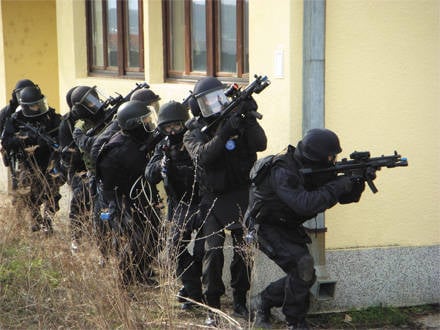
Since ST 6 was small in numbers (at different times from twenty to twenty-five operators), during the implementation of special operations, the SPU and KFOR divisions were involved as attached forces. Most often, the operators TEAM SIX worked with SPU Ukraine. The choice of Ukrainian special forces was not accidental. Of the countries represented in the SPU, Ukraine turned out to be more ready to work with ST 6. In TEAM SIX, it was believed that Ukrainians are less likely than others to reason, they work in cold blood, hard, and efficiently. As for the KFOR army units, the closest cooperation was established with the contingents of Great Britain and Sweden.
During the existence of ST 6 conducted more than five hundred special operations to capture highly dangerous armed criminals, while not suffering losses.
The local press has never mentioned the existence, and even more combat use of ST 6. So, after the detention by operators of TEAM SIX, Rama Maraj, a former presidential adviser Ibrahim Rugova, a statement appeared in the press that local police had arrested Maraj.
Eyewitnesses of the detention themselves told reporters that they saw this only in the movies.
Not without the participation of ST 6 and in the world press jointly-acclaimed UNMIK police operation with KFOR to free the courthouse in the northern part of the city of Kosovska Mitrovica in March 2008.
It was this unit with the support of the SPU of Ukraine and the units from the CPU (Close Protection Unit) conducted a successful operation to clean up the courthouse and arrest the fifty-four people inside. Two high-rise buildings, interconnected, were cleaned from the basement to the attic in record time (just over an hour). The phase of the operation assigned to ST 6 was performed at a high professional level, without a single shot.
In the future, illiterate actions of the general leadership of the operation led to riots and the sheer out of control of the situation. The column with the detainees was blocked by the Serbs; as a result, some of those arrested were beaten off by force, the staff of the UN Mission were released, but their cars were burned. The forces of the SPU of Poland, Ukraine, Romania, and others, as well as the French division of KFOR, had to be pulled to the scene. ST 6 officers were instructed to prevent any attempts to re-seize the courthouse, and then escort the columns with the remaining arrested into the Albanian part of the city along an alternative road. The task was once again successfully completed, and once again there was not a single mention of the division in the press.
In fact, such an aura of secrecy did not in any way hurt the feelings of ST 6 employees. In the team, serving was prestigious and honorable for any operator of a European police special forces. Employees of such well-known anti-terror units as the German GSG-9, the Austrian EKO COBRA and the Norwegian DELTA, annually performed tasks on a rotational basis in ST 6. Those who did not pass the entrance tests, and such cases were even with experienced operators, could remain in the team of technicians, that is, employees who are not directly involved in military operations.
The date of the official dissolution of ST 6 is considered to be 15 in November 2008 of the year. It was then that the mandate of the UN Mission in Kosovo ended, and the authority was transferred to the EU Mission. At the moment, the tasks assigned to ST 6 have been transferred to the Intervention Group (IG) in EULEX.
Former employees of TEAM SIX do not just keep in touch with each other, but annually hold meetings and seminars at the bases of various special forces of Europe in order to exchange experience and build closer relations between people from different countries who have chosen a difficult and noble profession whose name is special forces.
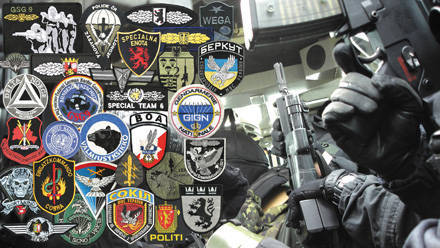
Divisions represented in TEAM SIX: GSG-9 (Germany), SEK (Germany), EKO COBRA (Austria), WEGA (Austria), DELTA (Norway), GIGN (France), URNA (Czech Republic), Zásahová jednotka (Czech Republic), Specialna Enota (Slovenia), Karhu Team (Finland), Alfa (Croatia), BOA (Poland), Nationell Insatsstyrkan (Sweden), Viking Squad (Iceland), ETF (Canada), Sokol (Ukraine), Bercut (Ukraine).
Information